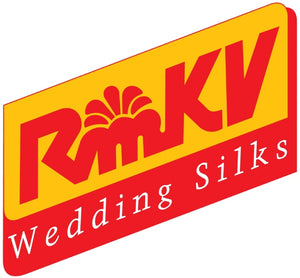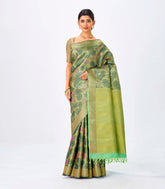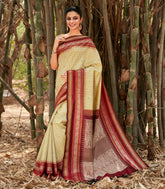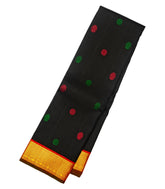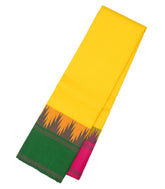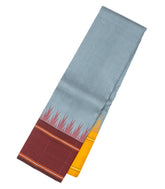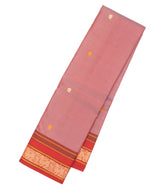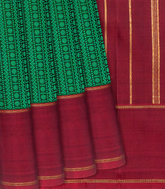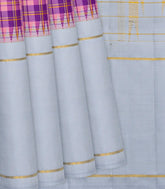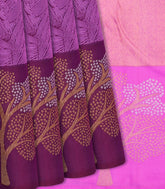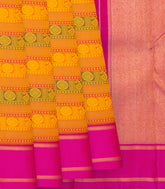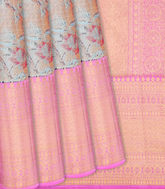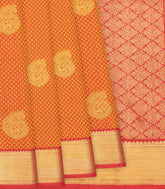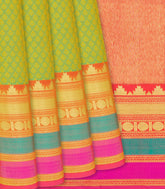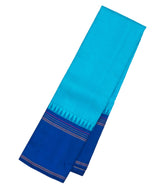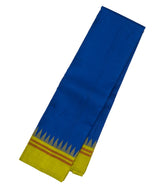-
Cardamom Green Handloom Kanchipuram Silk Saree With Lotus Floral Motifs
This handwoven kanchipuram silk saree is filled with lotus floral motifs in cardamom green body along with zari border and palluMRP:- ₹21,328
- ₹21,328
- Unit price
- per
-
Off White Handloom Korvai Kanchipuram Silk Saree With Checks
This handwoven korvai kanchipuram silk saree is filled with silk thread checks in off white body along with horse and elephant motifs in contrast silk thread work border and palluMRP:- ₹23,841
- ₹23,841
- Unit price
- per
-
Black Handloom Kanchipuram Silk Saree With Gandaberunda Buttas
This handwoven kanchipuram silk saree is filled with gandaberunda buttas in black body along with contrast red zari border and palluMRP:- ₹22,360
- ₹22,360
- Unit price
- per
-
Lemon yellow Handloom Kanchipuram Korvai Silk Saree With Ganga Jamuna Border
This handwoven kanchipuram silk saree is filled with plain lemon yellow body along with contrast ganga jamuna border and palluMRP:- ₹18,232
- ₹18,232
- Unit price
- per
-
Grey Handloom Kanchipuram Korvai Silk Saree With Ganga Jamuna border
This handwoven kanchipuram silk saree is filled with plain grey body along with contrast ganga jamuna border and palluMRP:- ₹16,856
- ₹16,856
- Unit price
- per
-
Dusty Pink Handloom Kanchipuram Silk Saree With Elephant Motifs
This handwoven kanchipuram silk saree is filled with elephant motifs in dusty pink body along with silk thread work border and palluMRP:- ₹15,996
- ₹15,996
- Unit price
- per
-
Sea Green Handloom Kanchipuram Silk Saree With Traditional Motifs-Sea Green
This handwoven kanchipuram silk saree is filled with traditional motifs in sea green body along with plain border and palluMRP:- ₹25,112
- ₹25,112
- Unit price
- per
-
Pink & Purple Handloom Kanchipuram Korvai Silk Saree With Checks-Pink
This handwoven kanchipuram korvai silk saree is filled with checks in purple & pink body along with contrast grey temple border and palluMRP:- ₹27,180
- ₹27,180
- Unit price
- per
-
Magenta Handloom Kanchipuram Silk Saree With Abstract Motifs-Magenta
This handwoven kanchipuram silk saree with abstract motifs in magenta body along with tree zari buttas in border and contrast hot pink palluMRP:- ₹28,518
- ₹28,518
- Unit price
- per
-
Mustard Handloom Kanchipuram Silk Saree With Mango Motifs in Stripes & Pink Border-Mustard
Mustard Handloom Kanchipuram Silk Saree With Mango Motifs in Stripes & Pink Border-MustardMRP:- ₹29,913
- ₹29,913
- Unit price
- per
-
Multi Colour Handloom Kanchipuram Silk Saree With Peacock Motifs-Multi colour
This handwoven kanchipuram silk saree with peacock motifs in body along with pink zari border and palluMRP:- ₹84,468
- ₹84,468
- Unit price
- per
-
Red Handloom Kanchipuram Silk Saree With Mango Zari Buttas-Red
This handwoven kanchipuram silk saree is brocaded with droplet motifs in silk thread along with mango zari buttas in red body & diagonal stripes in pure golden zari border & palluMRP:- ₹33,550
- ₹33,550
- Unit price
- per
-
Green Handloom Kanchipuram Silk Saree With Floral Motifs-Green
This handwoven kanchipuram silk saree is filled with floral motifs in green body along with rudraksham motifs in border and palluMRP:- ₹22,080
- ₹22,080
- Unit price
- per
-
Sky Blue Handloom Korvai Kanchipuram Silk Saree With Stripes
This handwoven korvai kanchipuram silk saree is filled with stripes in sky blue body along with contrast blue temple border and palluMRP:- ₹19,350
- ₹19,350
- Unit price
- per
-
Blue Handloom Korvai Kanchipuram Silk Saree With Green Border
This handwoven korvai kanchipuram silk saree with plain blue body along with contrast green temple border and palluMRP:- ₹19,350
- ₹19,350
- Unit price
- per
Subscribe To Our Newsletter
Receive early access to new arrivals, sales, exclusive content, events and much more!
